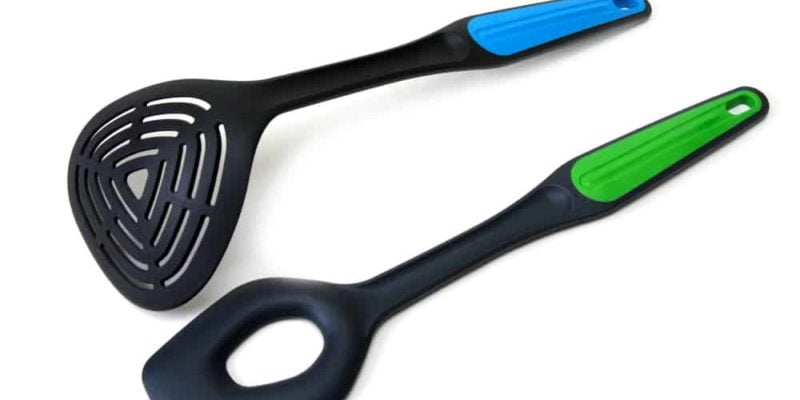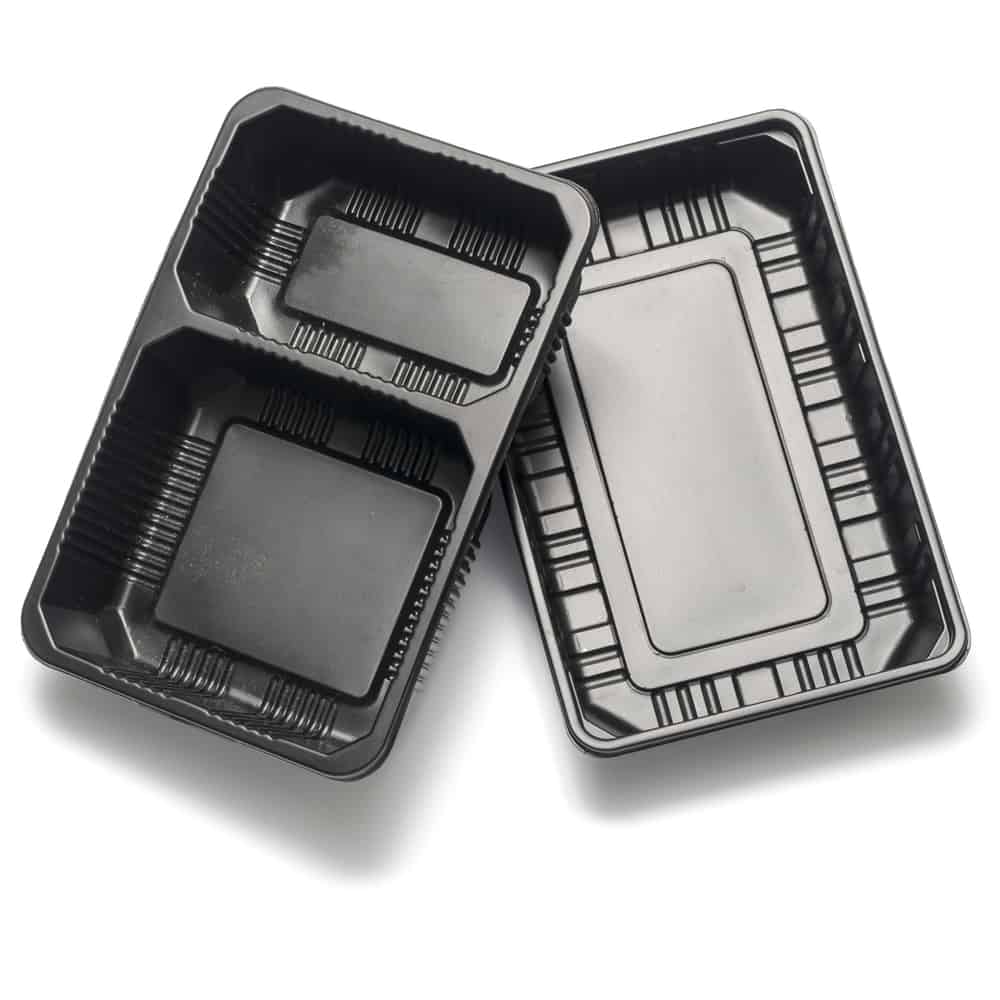Just when you thought that organic TV dinner was a good idea, a study published in the journal Environment International released shocking information about what is inside black plastics. It draws attention to our circular economy of plastics and the recycling of plastic where we use plastic, throw it away, and then recycle it into new things. Could recycled plastic be harming our health? And should it ever be used in food contact materials? For consumers, black plastic is used in several single-use products that come in contact with food and drink like thermos cups, drink stirrers, eating utensils, coffee lids, coffee cups & frozen food trays. On a more re-usable basis, black plastics are also used for food containers, kitchen appliances like coffee machines, cooking utensils, bowls & plates. You’ve trusted Mamavation to cover topics like toxins that lower your IQ, hormone-disrupting chemicals linked to weight gain, & simple steps to selecting safe personal care products, now join us as we explore the shocking truths behind black plastics and the potential hormonal impact they can have on your body.
Disclosure: this post contains affiliate links
Table of Contents
What Was Found in Black Plastic Materials
The black plastic study was led by Andrew Turner of Plymouth University in the United Kingdom. He used XRF spectrometry to assess the levels of a range of elements in more than 600 pieces of black plastic products that come into contact with food & beverages, storage, clothing, toys, jewelry, office items and new and old electronic and electrical equipment. But most importantly, he tested 129 black plastic items used in contact with food & beverage. What he found was the presence of brominated flame retardants, chlorine, PVC, cadmium, chromium, mercury, lead, and antimony. Most of these substances are not safe for human consumption, even at small levels. So what exactly was found and how much was in food contact materials?
- Chromium was detected in 35 pieces
- Brominated flame retardants were detected in 29 pieces
- Antimony was detected in 20 pieces
- Lead was detected in 18 pieces
- Additional elements detected were PVC, cadmium & mercury
Turner was quoted as saying “There are environmental and health impacts arising from the production and use of plastics in general, but black plastics pose greater risks and hazards.”
How Are Dangerous Chemicals Getting Into Black Plastic?
The question then becomes how are all these dangerous chemicals finding their way into black plastic. Well, it comes down to the circular economy we have created around plastic in general. Plastics are recycled as often as possible in order to stop them from finding their way into landfills and the oceans where they can do serious damage to the environment. The green economy has been promoting recycled plastic use for a very long time. But did anyone stop to think about the potential hormonal impacts of what would happen if dangerous chemicals found their way into plastic and then leached into our food and drink? Evidently not. And studies are mounting telling us that recycled plastics aren’t really as good of an idea as we originally thought.
Turner explains “Black products constitute about 15% of the domestic plastic waste stream, of which the majority is single-use packaging and trays for food.” However when it comes to black plastics, “there is mounting evidence that the demand for black plastics in consumer products is partly met by sourcing material from the plastic housings of end-of-life waste electronic and electrical equipment (WEEE).” He then recommends “future scientific research should focus on the behavior and migration of additives that have been recycled into sensitive consumer goods like food-contact items, drinks vessels, and small toys.”
Long story short, these substances are originally found in end-of-life electronic devices like laptop computers, mobile phones, music systems, video consoles, DVD or Blue Ray players, cable boxes & home theater systems. When these electronic devices are discarded, the pieces are separated into different resources and then recycled or sent to a landfill in another country. The dark plastic pieces end up getting recycled with other pieces and end up in new plastic products. And that is how you get dangerous electronic chemicals inside black plastic.
How Dangerous Chemicals Inside Black Plastics Can Find Their Way Into Your Food
The chemicals inside black plastic pose a problem to human health when they escape. Leaching is the term used to describe how chemicals migrate out of plastic and into the food & beverages they contain. In order for this to happen, one of three scenarios need to be involved:
- Heat, like sticking something in the microwave, leaving something in your car or the presence of hot food;
- Fat, like cheese, fatty meats or oils;
- Acid, like citric acid.
The trifecta of all this would be a black plastic bowl containing spaghetti sauce because within that bowl you have heat, fatty oils & citric acid from the tomatoes. So that bowl of spaghetti you ordered from the Italian bistro down the street that came to you within 20 minutes from Uber Eats is a bit more than you bargained for. You didn’t pay for the ingredients to expand to lead, brominated flame retardants, chlorine, PVC, cadmium, chromium, mercury, and antimony, but that may be also part of your meal. In addition to this being problematic to your health, it also poses a problem to the environment whereas contaminated black plastic is breaking down in landfills and inside the oceans. Could this also be contributing to the toxicity problems with seafood? Likely.
What Are the Potential Health Impacts of Black Plastic to Your Family?
Most of the chemicals found have a toxic and endocrine-disrupting effect on humans, especially pregnant women, small children, adolescents & women going through menopause. Anyone of these chemicals that have a hormone-disrupting effect can be very dangerous at small levels to those populations. Below are some health impacts to be cautious of when dealing with the chemicals that are showing up in black plastics.
- Chromium is carcinogenic, irritates the respiratory tract when inhaled, but when ingested can cause problems in the stomach and small intestines (gut health), ulcers, damage to sperm, miscarriages, low birth weight, etc.
- Brominated flame retardants are hormone-disrupting chemicals linked to thyroid disruption, memory and learning problems, delayed mental and physical development, lower IQ, advanced puberty and reduced fertility.
- Chlorine is a hormone-disrupting chemical that can cause damage to the gastrointestinal tract when ingested
- PVC is a carcinogen and hormone-disrupting chemical that also likely contains phthalates and is linked with obesity and sperm damage, among various cancers
- Cadmium is a neurotoxin and hormone-disrupting chemical linked to reduced fertility, damage to the central nervous system, damage to the immune system, psychological disorders, and cancers.
- Mercury is a neurotoxin and hormone-disrupting chemical linked to damage in cognitive impairment, loss of memory, poor attention span, language development & fine motor skills, visual-spatial skills, reduced fertility, mood swings, skin rashes or dermatitis, muscle weakness, etc.
- Lead is a carcinogen and hormone-disrupting chemicals linked to anemia, weakness, and kidney and brain damage, reduced fertility, behavioral issues like poor impulse control & violence, lowering of the IQ, miscarriages, stillbirths, etc.
- Antimony is suspected to be a carcinogen and causes irritation of the eyes, skin, and lungs when inhaled, but is more troublesome with fertility causing miscarriages & stillbirths. Long-term inhalation of antimony can potentiate pneumoconiosis, altered electrocardiograms, stomach pain, diarrhea, vomiting, and stomach ulcers.
 What You Can Do to Avoid Black Plastics
What You Can Do to Avoid Black Plastics
At Mamavation we believe the less plastic you have in contact with your food, the better. Why take chances with your loved ones? And when you think about how to avoid plastic, think in terms of things that come in contact with your food & beverages and then things that children would place inside their mouths. Some of the things I altered in my life was the following:
- Kitchen appliances like blenders that have plastic touching food (or nonstick chemical surfaces)
- My coffee maker
- Plastic containers used for food storage
- Plastic cups, bowls & plates
- Take-out in plastic containers (styrofoam is actually WORSE so avoid that too as much as possible)
- Watching the children and adding “not sticking plastic in your mouth” as one of those things I constantly say in the home like a broken record
For more information, pick up a copy of Green Enough: Eat Better, Live Cleaner, Be Happier (All Without Driving Your Family Crazy!) for tips and tricks on how to avoid most of the hormone-disrupting chemicals that sneak their way into your home. Chapter 2 of this book is devoted to food packaging and how these “indirect additives” leach into your food & beverages without your consent or knowledge. With this book, you’ll be able to slay most of the toxic fowl-breathed monsters like a green ninja while laughing because we make detoxing your home fun. Seriously.
And if you are looking for new products to replace the ones you have in your kitchen that could be leaching dangerous chemicals into the food you feed your family, you can browse through our curated Amazon shopping portal by using the drop-down menu to find things like:
Kitchen appliances without plastic touching food
Coffee Makers without plastic touching your coffee
Lunch boxes for the kids made from stainless steel
I’m here for you girl! And if you want to join our community on Facebook for support from other women who are just like you click here. (Ladies only and it’s FREE!) And also make sure you sign up for our newsletter to stay up to date on all these issues impacting the health of your family.







 What You Can Do to Avoid Black Plastics
What You Can Do to Avoid Black Plastics Thousands of Doctors Blame Obesity on Hormone-Disrupting Chemicals Called “Obesogens”
Thousands of Doctors Blame Obesity on Hormone-Disrupting Chemicals Called “Obesogens”
If you want to deep dive into being environmentally friendly and are into using goods that have longevity and are safe for you, check out the “zero waste” forums.
For those looking for a coffee maker, use a french press. No coffee maker required.
Also, it somehow seems offensive to have black people in the photo for this article. Were there no photos of white people using black straws?
I am so glad I got to read this when I did cuz now I’m happy to say that I am all okay in this area
What is a good type of coffee maker?
Hey Elise! I have an old-fashioned Cemex. You can find it here on Amazon, https://amzn.to/2CAAUlJ. The coffee tastes so much better when it’s not going through plastic.
An unused one
….and I’m now in the market for a new coffee maker!
That’s wonderful! Hope you find some from our list that you like! XXOO
We just need to stop using plastic as storage containers and go back to wood or glass.
That’s a GREAT idea Selena! And they look better too!